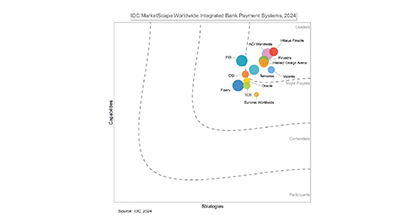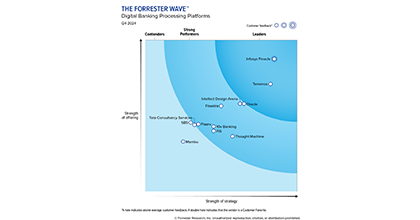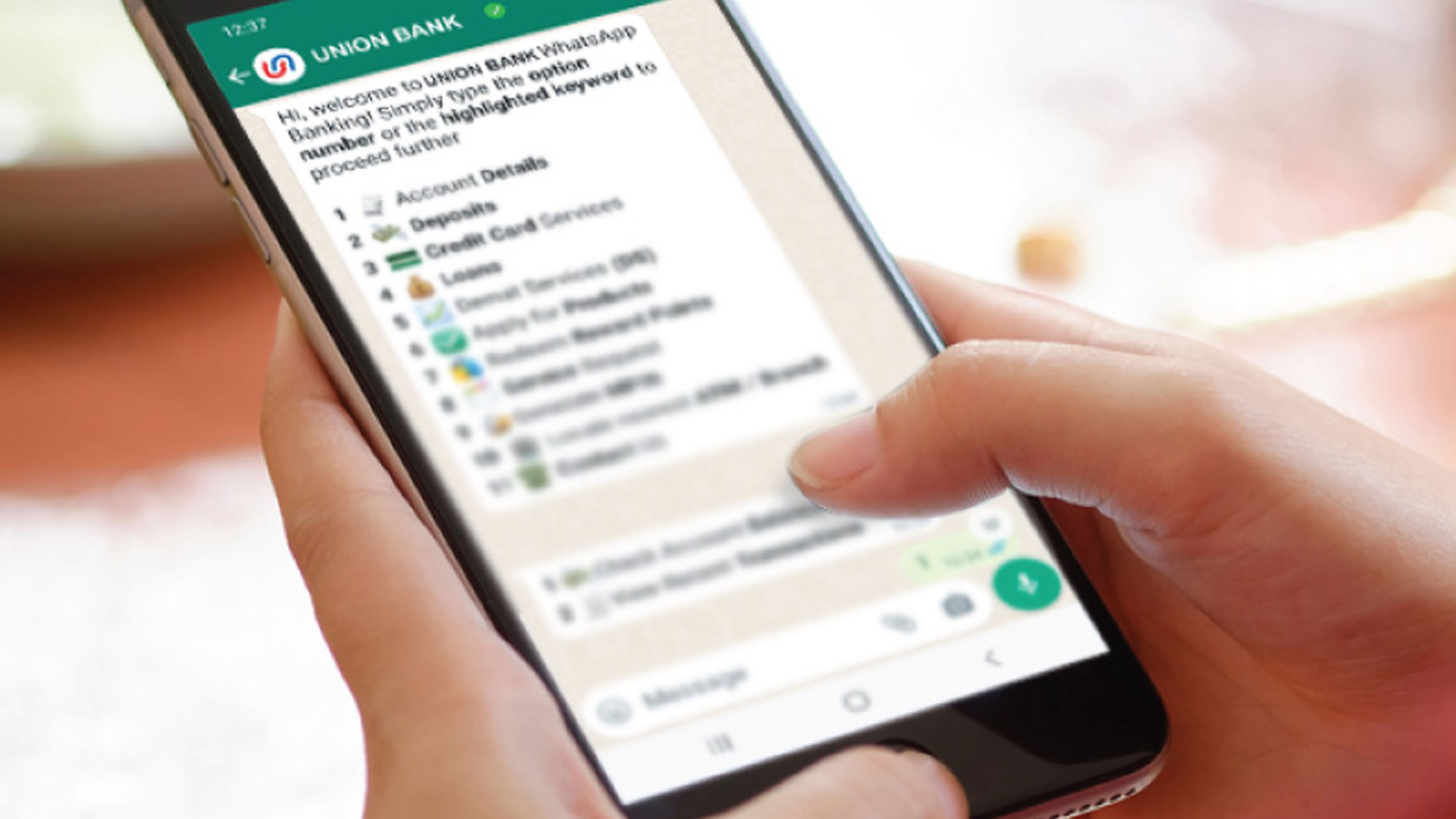-
![]() Quantum Computing: As the Future Awaits, The Strides Are DefinitiveQuantum computing is no longer confined to theory or the edges of experimental science - it is rapidly advancing toward practical impact.Read More
Quantum Computing: As the Future Awaits, The Strides Are DefinitiveQuantum computing is no longer confined to theory or the edges of experimental science - it is rapidly advancing toward practical impact.Read More -
![IDC IDC]() IDC MarketScape: Worldwide Integrated Bank PaymentFinacle Payments is an enterprise payments services system that manages end-to-end payments across instrument types, payment schemes, transaction types, customeRead More
IDC MarketScape: Worldwide Integrated Bank PaymentFinacle Payments is an enterprise payments services system that manages end-to-end payments across instrument types, payment schemes, transaction types, customeRead More -
![]() Supply Chain FinanceToday, as businesses seek to make their ecosystems more resilient, Supply Chain Finance (SCF) has emerged as a powerful lever for banks and financial institutions to support clients, while unlocking new revenue streams.Read More
Supply Chain FinanceToday, as businesses seek to make their ecosystems more resilient, Supply Chain Finance (SCF) has emerged as a powerful lever for banks and financial institutions to support clients, while unlocking new revenue streams.Read More
-
![]() The Future of Core Banking: Business and Technology EvolutionOur point of view paper, “The Future of Core Banking: Business and Technology Evolution”, serves as a candid and forward-looking benchmark of your institution’s readiness—and a strategic playbook for core modernization.Read More
The Future of Core Banking: Business and Technology EvolutionOur point of view paper, “The Future of Core Banking: Business and Technology Evolution”, serves as a candid and forward-looking benchmark of your institution’s readiness—and a strategic playbook for core modernization.Read More -
![The Forrester Wave The Forrester Wave]() Forrester Wave Digital Banking, Q4 2024Finacle is best suited for large retail, SMB, and corporate banks who seek a modern, comprehensive, innovative platform with superior support.Read More
Forrester Wave Digital Banking, Q4 2024Finacle is best suited for large retail, SMB, and corporate banks who seek a modern, comprehensive, innovative platform with superior support.Read More -
![]() Driving Comprehensive Revenue ManagementDiscover why revenue management must evolve into a comprehensive, strategic capability. Decode a blueprint to overcome challenges and unlock sustainable monetization.Read More
Driving Comprehensive Revenue ManagementDiscover why revenue management must evolve into a comprehensive, strategic capability. Decode a blueprint to overcome challenges and unlock sustainable monetization.Read More
-
![]() Shaping Banking’s Next: Banking Technology Trends for 2025 and BeyondThe banking industry has been balancing disruption and opportunity for several years now, and the pace of change shows no signs of slowing as we move into 2025 and beyond.Read More
Shaping Banking’s Next: Banking Technology Trends for 2025 and BeyondThe banking industry has been balancing disruption and opportunity for several years now, and the pace of change shows no signs of slowing as we move into 2025 and beyond.Read More -
![]() Virtual Accounts 2.0: Surpass Conventional Cash Management and Unlock Next-Gen PossibilitiesVirtual Account Management was a groundbreaking shift in the banking landscape, revolutionising use cases like cash concentration, pooling, centralised treasury management, and in-house banking (POBO, ROBO, COBO)Read More
Virtual Accounts 2.0: Surpass Conventional Cash Management and Unlock Next-Gen PossibilitiesVirtual Account Management was a groundbreaking shift in the banking landscape, revolutionising use cases like cash concentration, pooling, centralised treasury management, and in-house banking (POBO, ROBO, COBO)Read More -
![]() Unlocking Hybrid CloudAs banks push forward with their digital transformation agenda, cloud serves as a pivotal enabler. Each bank, at varying stages of adoption, crafts its unique path, dictated by context, regulations, and risk appetite.Read More
Unlocking Hybrid CloudAs banks push forward with their digital transformation agenda, cloud serves as a pivotal enabler. Each bank, at varying stages of adoption, crafts its unique path, dictated by context, regulations, and risk appetite.Read More
-
![]() Banking on CloudThis report from Infosys Finacle delves into the need for accelerating cloud adoption, highlights the current state of the industry, and puts forth key recommenRead More
Banking on CloudThis report from Infosys Finacle delves into the need for accelerating cloud adoption, highlights the current state of the industry, and puts forth key recommenRead More -
![]() Omdia Universe | Cloud-based Core BankingIn the report, Omdia highlights the following key capabilities of leading cloud-based core banking providers:Read more
Omdia Universe | Cloud-based Core BankingIn the report, Omdia highlights the following key capabilities of leading cloud-based core banking providers:Read more
-
![]() Emirates NBDEmirates NBD consolidates its operations on a single version for scalability, agility, and standardization.Read More
Emirates NBDEmirates NBD consolidates its operations on a single version for scalability, agility, and standardization.Read More -
![]() A Global Top 5 BankDiscover how a global top 5 bank headquartered in the US accelerated payments transformation.Read More
A Global Top 5 BankDiscover how a global top 5 bank headquartered in the US accelerated payments transformation.Read More -
![]() Union Bank of IndiaUnion Bank of India launches Union Virtual Connect (UVConn) by leveraging WhatsApp to provide customers personalized banking services.Read More
Union Bank of IndiaUnion Bank of India launches Union Virtual Connect (UVConn) by leveraging WhatsApp to provide customers personalized banking services.Read More

Liquidity Management in the Age of Real-Time Payments
Blogs
In today’s fast-paced financial landscape, corporates and SMEs are under increasing pressure to optimize liquidity and improve working capital management. The rise of real-time payments and access to instantaneous financial data is transforming the way businesses manage cash. But how can they fully leverage these developments—and what more is needed to bring liquidity management into real-time?
Real-Time Payments vs. Real-Time Data: A Crucial Distinction
It’s important to distinguish between real-time payments and real-time data—two interrelated but distinct components of modern liquidity management. Real-time payments refer to the instantaneous transfer and settlement of funds, enabling faster movement of money. Real-time data, on the other hand, involves immediate access to up-to-date financial information, such as balances, transaction status, and cash flow metrics.
Both are essential, but it's the convergence of these capabilities that unlocks transformative value. Without real-time data, even instant payments can fall short of delivering true liquidity insights. And without real-time payments, real-time data lacks the power to drive action.
Leveraging Real-Time Payments for Better Liquidity Management
For corporates and SMEs alike, real-time payments provide immediate visibility into cash inflows and outflows. This instant access to payment data enables businesses to:
- Make faster and more informed decisions about investing surplus cash or drawing on credit lines.
- Reduce the need for large liquidity buffers, since cash positions can be monitored and adjusted in real time.
- Enhance forecasting accuracy by using current transaction data rather than relying on outdated reports.
In Europe, the SEPA Instant Credit Transfer (SCT Inst) scheme has been a major catalyst. It enables euro transactions across participating countries to be settled within seconds—giving businesses the ability to manage liquidity dynamically across borders.
Automating Cashflow Processes: A Critical Enabler
Automation is the bridge between real-time data and actionable insights. By automating key cashflow processes—such as reconciliation, cash positioning, and forecasting—companies can:
- Eliminate manual errors and inefficiencies that delay decision-making.
- Free up finance teams to focus on strategic activities rather than repetitive tasks.
- Integrate diverse data sources, such as bank accounts, ERP systems, and payment platforms, to provide a unified view of liquidity.
For example, many European banks are integrating with PSD2 open banking APIs to allow corporates to pull real-time bank data directly into their treasury systems, accelerating automation and decision-making.
What More Is Needed?
Despite these advancements, real-time liquidity management is not yet the norm. Several barriers remain:
- Legacy infrastructure: Many businesses and banks still operate on batch-based systems that limit real-time capabilities.
- Lack of interoperability: Fragmented systems and inconsistent data formats across platforms hinder end-to-end visibility.
- Cultural and operational resistance: Embracing real-time finance requires not just technology, but also a mindset shift within finance departments.
In the EU, regulatory support such as the proposed Instant Payments Regulation aims to make instant payments mandatory across member states—paving the way for more widespread adoption of real-time liquidity tools.
The Rise of Treasury as a Service (TaaS)
Treasury as a Service is emerging as a compelling model, especially for mid-sized companies without large in-house treasury functions. TaaS solutions offer cloud-based, modular services that can include:
- Real-time cash visibility
- Automated payments and collections
- Liquidity forecasting
- Risk management tools
With the growing maturity of fintechs in Europe—like Tink (Sweden) or Nomentia (Finland)—businesses can access plug-and-play treasury solutions without massive up-front investment. As these platforms integrate more deeply with banks and ERPs, TaaS could become a mainstream model within the next few years.
Conclusion
Europe is already laying strong foundations for real-time treasury operations—through initiatives like SEPA Instant, PSD2, and regulatory momentum toward instant payments. The convergence of real-time payments and real-time data, supported by automation and digital platforms, is reshaping liquidity management. While some hurdles remain, the direction is clear—and businesses that embrace this shift early will be in a strong position to optimize cash and compete globally.
Infosys Finacle is sponsoring EBA Day 2025 – the premier European summit for payments and transaction banking professionals. We will participate in a panel session on ‘Liquidity Management and Real Time Payments. This session will discuss how corporates and SMEs can leverage real-time data to enhance liquidity and working capital management. The session will also explore the role of automation in cash flow processes and the future of Treasury as a Service (TaaS). We hope to see you there.


Download the Latest Report
The Future of Core Banking: Business and Technology Evolution


©2025 -Edgeverve Systems Limited | All rights reserved















